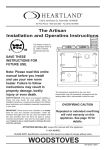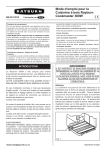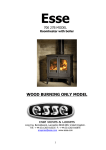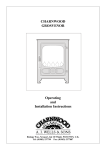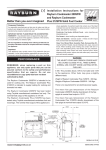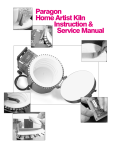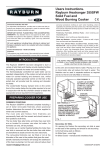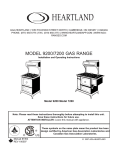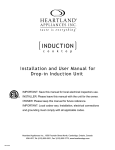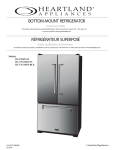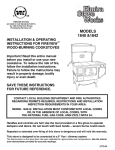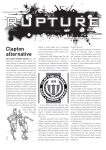Download Heartland Wood Stove Stove User Manual
Transcript
1050 Fountain St N. Cambridge, Ontario, Canada N3H-4R7 Business (519) 650-5775 Fax (519) 650-3773 Toll Free Phone: 1-877-650-5775 Toll Free Fax: 1-800-327-5609 The Artisan Installation and Operating Instructions The Artisan is listed to ULC Standard S-627 & UL 1482 by Warnock Hersey Professional Services Ltd SAVE THESE INSTRUCTIONS FOR FUTURE USE. Note: Please read these instructions thoroughly before attempting to install this unit. SAFETY NOTICE: If this stove is not properly installed, a house fire may result, for your safety, follow the installation directions, contact local building or fire officials about restrictions and installation inspection requirements in your area. IMPORTANT: Check around oven chamber on a weekly basis for soot and creosote accumulation. Clean the chamber thoroughly from the top, side and bottom with the rake provided. Burn the stove hot daily to reduce creosote accumulation. Use only dry wood aged for one year. Failure to do so could result in chimney fire and void the warranty. The temperature registered by the oven door thermometer may not necessarily correspond with the reading taken with a thermometer inside the oven OVERFIRING CAUTION Repeated or extended overfiring will void warranty on this appliance. See page 18 for details. ATTENTION INSTALLER: Leave this manual with the appliance. © 2006 HEARTLAND APPLIANCES INC. PLEASE NOTE: Specifications contained in this manual are subject to change without notice WOODSTOVES 01/07 EINS 515000 FOR YOUR SAFETY DO NOT STORE OR USE GASOLINE OR OTHER FLAMMABLE VAPOURS OR LIQUIDS IN THE VICINITY OF THIS STOVE. Stove Location - If the stove must be located near a window, avoid using long curtains which could blow over the stove top, causing a fire hazard. Any openings in the wall behind the stove or in the floor under the stove must be sealed. Do not set unopened glass or metal containers on the stove. Grease accumulation is the cause of many cooking fires. Clean the oven compartment regularly. Do not attempt to extinguish a grease fire with water. Cover grease fires with a pot lid or baking soda. Avoid the use of aerosol containers near the stove. 2 Artisan CONSUMER WARRANTY ENTIRE PRODUCT –LIMITED ONE YEAR WARRANTY HEARTLAND warrants the replacement or repair of all parts of the Artisan which prove to be defective in material or workmanship. Painted porcelain enamel finish or plated surfaces have a 90 day warranty from the date of original purchase. Such parts will be replaced or repaired at the option of Heartland without charge, subject to the terms and conditions set out below. The warranty does not include normal wear or firebox parts or gaskets. TERMS AND CONDITIONS 1. This warranty applies only for single family domestic use when the Wood Cookstove has been properly installed according to the instructions supplied by Heartland and is connected to an adequate and proper chimney and chimney connections. Damage due to faulty installation, improper usage and care, abuse, accident, fire, flood, acts of God, commercial, business or rental use, and alteration, or the removal or defacing of the serial plate, cancels all obligations of this warranty. Service during this warranty must be performed by a factory Authorized Service Person. 2. Warranty applies to product only in the country in which it was purchased. 3. Heartland is not liable for any claims or damages resulting from any failure of the Wood Cookstove or from service delays beyond their reasonable control. 4. To obtain warranty service, the original purchaser must present the original Bill of Sale, Model and Serial number. Components repaired or replaced are warranted through the remainder of the original warranty period only. 5. The warranty does not cover expense involved in making this appliance readily accessible for servicing. 6. This warranty gives you specific legal rights. Additional warranty rights may be provided by law in some areas. 7. Adjustments such as calibrations, levelling, tightening of fasteners, or chimney and chimney connections normally associated with original installation are the responsibility of the dealer or installer and not that of the Company. 8. Overfiring of this appliance will void warranty. Some crazing may occur if the cast top surface is quickly cooled by spillage of liquids and by overfiring of the cooker. TO ENSURE PROMPT WARRANTY SERVICE, SEND IN YOUR WARRANTY CARD WITHIN 10 DAYS OF PURCHASE. If further help is needed concerning this warranty, contact: Customer Service Heartland Appliances Inc. 1050 Fountain St N. Cambridge, Ontario, N3H-4R7 Business (519) 650-5775 Fax (519)650-3773 Toll Free Telephone1-877-650-5775 PLACE OF PURCHASE: DATE OF PURCHASE: SERIAL NUMBER: MODEL NUMBER: 3 TABLE OF CONTENTS 1) Welcome ........................................................................................................................... Pg 5 2) Installation ......................................................................................................................... Pg 6 3) Installation Requirements ................................................................................................. Pg 7 4) Clearances Single Wall Connector .................................................................................. Pg 8 5) Clearances Double Wall Connector ................................................................................. Pg 9 6) Installing the Chimney Connector ..................................................................................... Pg 10 7) Chimney and Draft ............................................................................................................ Pg 11 8) Floor Protection ................................................................................................................ Pg 11 9) User Instructions ............................................................................................................... Pg 12 10) Door Operation ................................................................................................................. Pg 13 11) Lighting the Fire ................................................................................................................ Pg 13 12) Refuelling ...........................................................................................................................Pg 14 13) Break-In Fire ..................................................................................................................... Pg 15 14) Flue way Cleaning ............................................................................................................ Pg 16 15) Fresh Air Kit ...................................................................................................................... Pg 17 16) Understanding Combustion .............................................................................................. Pg 17 17) Over firing ......................................................................................................................... Pg 18 18) Trouble Shooting .............................................................................................................. Pg 19 19) Cooking Instruction ........................................................................................................... Pg 22 19) Contact Information .......................................................................................................... Pg 24 4 Welcome Safety Notice: If your stove is not properly installed and maintained, a house fire may result. For your safety, follow all installation, operation and maintenance directions. Contact local building officials about restrictions and installation inspection requirements in your area. (“Makeshift” compromises in the installation may result in hazardous conditions, including a house fire.) Getting Acquainted The Artisan stove is a time proven heating and cooking appliance. Take your time to acquaint yourself with the principles on which your new stove operates as a heater and a cooking stove. Familiarizing yourself with the primary principles of the air intake controls, the oven damper, the flame path for the fire and the relationship to the chimney will give you a very comprehensive understanding of what you are trying to accomplish with the stove. Note: DO NOT connect to or use in conjunction with any air distribution ductwork. This stove is not approved for such installations. DO NOT use chemical fluids to start the fire. Save These Instructions DO NOT burn garbage or flammable fluids such as gasoline or engine oil. Keep the manual available for future reference. The manual is an important part of your stove. If your stove is sold, deliver the manual to the new owner along with the stove. CAUTION: Stove is hot while in operation. Keep children, clothing and furniture away. Contact may cause skin burns. The quality of the installation (especially the chimney connector and chimney), and the quality of the fuel being burned will affect the performance of your stove, but the most important factor is the way you operate the stove. With the help of this manual, you will learn how to effectively heat and cook with your stove. Be sure to read it entirely, including the terms of reference and function. Spend some time becoming familiar with the various parts of the stove by operating them before you burn your stove. After a few weeks of operating the stove, re-read this manual. Many of the procedures will become clearer after you have had some experience with the stove. In addition, your own experience will help you to learn the role that the chimney plays in stove performance. The Artisan has been tested and is listed by Warnock Hersey. The test standards are ULC S-627 for Canada and UL 1482 for U.S. The serial number is located on a pull-out plate at the bottom right hand side of the front of the unit. The listed rating plate is located on the back wall of the unit. The Artisan is listed for burning wood only. Do not burn other materials or garbage. The Artisan is not listed for installation in mobile homes. Do not install the stove in mobile homes. 5 Installation Place the stove in the intended position and lift out the hotplate, checking that the joint between the underside of the hob and the top of the stove is intact. Any joints which have opened should be made good with the fire cement provided. using to the clearances specified. Failure to do so will result in an unsafe condition. Unit must be placed on a continuous non-combustible pad (floor tile with grouting or sheet metal pad) extending 21” (540mm) in front and 8” (203mm) to the side and back. Replace the hotplate making sure that it is seated evenly on the soft rope and that it is approximately 0.1” (1.5mm) higher than the enamelled top plate, with an equal space all round. Fit the flue chamber which should have a rope seal already installed. The flue chamber is screwed to the stove making a good seal as any air leak at this point will impede the working of the stove. Air flowing between the stove pipe and nearby surfaces carries away heat. Do not fill the empty space with any insulating material. A chimney approved to CSA B.365-01 in Canada or NFPA 211 in the USA must be used to connect to the stove pipe. P/N - RS4M301136 A Flue Chamber Box is located in Main Oven compartment during shipment. Remove all bubble wrap and protective film from inside of oven doors prior to stove ignition. Refer to Fig. 7 for definition of terms and installation orientation of Flue Chamber. a. Remove two screws (1/4” x 20) and fiber washers from oven top cutout. b. Prior to positioning Flue Chamber, ensure that chamber damper is in its full open position to allow for access to screw hole locations. c. Position Flue Chamber on stove top ensuring that it is nested as close as possible to the stove top, to allow for a minimal gap - front and side. d. Install fiber washers and 1/4” x 20 screws - ensuring fasteners are tightly securing Flue Chamber. e. Close Flue Chamber door. Fig. 1 DESN 515137 Handrail: The handrail brackets are held on the front ends of the stove top-plate casting. Remove the travel nuts and replace with the handrail brackets ensuring the fibre protecting washers are in position. Insert the handrail with fitted endcaps into the brackets, positioning them correctly, and tighten the locating bolts (See Fig. 1). Do not use handrail to move stove. Open the firebox and ashpit doors and check that the reciprocating bottom grate bars are in position. Make sure the three restriction plates are in place on the bottom grate - one at the front and two at the rear. The riddling lever will not operate with restriction plates in place - it is intended for cleaning purposes only. Endcaps, brackets and hardware, referenced in Fig. 1 are located in the lower warming drawer during shipment. Handrail is located on Stovetop in a round tube during shipment. Be sure to read the sections on clearances, floor protection and chimneys before actively starting the installation. Do not hang combustible material on handrail during stove operation. Warning A woodburning stove radiates heat in all directions. Heat directed toward living areas in front of the stove is usually very welcome. However, heat radiating in other directions will not be as welcome if it results in overheating nearby walls, ceilings and floors. An important part of planning a safe installation is to be sure that the combustible material located near your stove does not overheat. Clearance is the distance between your stove and stovepipe and nearby walls, ceilings and floors. If there is adequate clearance, then the nearby surfaces will not overheat. The ashpit and firebox door must be closed during normal use, except when lighting or refuelling Clearances must be maintained at all combustible material. These include doors, trim, furniture, drapes, newspapers and clothes. See local codes for a description of combustible material. Make sure that no floor or chimney supports will be cut due to chimney installation. Contact local building officials about restrictions and installation inspection in your area. It is very important that you match the stove pipe you are 6 Heartland Appliances Inc. 1050 Fountain St North, Cambridge, ON N3H 4R7 Installation Requirements Model Heartland Artisan Due to continuing product improvements, Heartland Appliances reserves the right to amend specifications without notice. Please contact Heartland for the most up to date information, as it applies to product being purchase, or download latest Site Preparation Specifications from www.heartlandapp.com. Help Desk 877-650-5775 CHIMNEY CONNECTOR REQUIREMENTS ARTISAN REQUIREMENTS How-to Steps Note: Information herein is for recommendation purposes only. All clearances are subject to local, Provincial or State building and fire codes. Clearances may change without notice. Always consult with local building inspector. Improperly installed and/or maintained stove may result in a house fire. How-to Steps Note: Information herein is for recommendation purposes only. All clearances are subject to local, Provincial or State building and fire codes. Clearances may change without notice. Always consult with local building inspector. Improperly installed and/or maintained stove may result in a house fire. Clearances Single Wall Stove Pipe z Left side of stove adjacent to combustible material: 6 inches/152.4 mm z Right side of stove adjacent to combustible material: 6 inches/152.4 mm z Rear clearance to combustible material: 6 inches/152.4mm z Corner clearance to combustible material: 6 inches/ 152.4mm z Front clearance to combustible material: 36 inches/915mm z Minimum clearance to combustible ceiling: 51.75 inches/1321mm Chimney Connector Approvals For Single and listed Double Wall Use only 6” diameter approved and listed chimney to the following standards: z z Canada: ULC Standard S629 U.S.: UL 103 HT Clearance Guidelines Part of planning a safe installation is to be sure that combustible materials located near your stove do not overheat. Safety Double Wall Stove Pipe z Left side of stove adjacent to combustible material: 3 inches/76.2 mm z Right side of stove adjacent to combustible material: 3 inches/76.2mm z Rear clearance to combustible material: 3 inches/ 76.2mm z Corner clearance to combustible material: 3 inches/ 76.2mm z Front clearance to combustible material: 36 inches/ 915mm z Minimum clearance to combustible ceiling: 51.75 inches/1321mm z z z z WARNING Combustible Walls z Please contact your local building inspector for confirmation of what construction materials are considered combustible or non-combustible in your particular application. Combustible materials include, but are not limited to, doors, trim, furniture, drapes, newspapers, woodpiles and clothes. z z Floor Protection Unit must be placed on a continuous non-combustible pad (floor tile with grouting or sheet metal pad) extending 21” (534mm) in front and 8” (203mm) to the sides and back of the unit. Hearth MUST extend to the walls if using clearances less than these dimensions. z z 7 Clearances specified herein must be adhered to as a minimum. Local building codes may require additional spacing. Please confirm with your local regulations before commencing any work. Floor or ceiling supports must not be cut due to chimney installation (adjust stove location accordingly to avoid chimney interference with these critical areas). Certain States require fresh air supply kits to be installed. Contact state or local authorities for specific details prior to installing unit. Do not pass stovepipe chimney connector through combustible walls. Always use an approved, insulated wall/ceiling pass through (refer to CSA B365 in Canada and NFPA 211 in U.S.) Do not use stovepipe as an outside chimney. Chimney connector should be exposed and accessible for inspection and cleaning (never pass through combustible ceiling). Chimney connector must be securely attached to the pipe and chimney. Individual sections must be attached together. Stove pipe must not be connected to an air distribution duct. Clearances to Combustibles Single Wall Chimney Connector All measurements must be done before starting the installation. Dimensions All drawings are for reference only, showing approximate dimensions for rough-in purposes. In some installations, two or more clearances to combustible walls may contradict each other. The clearances with the greater numerical value is to be used. Fig. 2 DESN 515002 Rough In Measurements Non-combustible hearth must extend 8 inches (203mm) to the sides and back of the unit. Must extend 21 inches (534mm) to the front in Canada and 18 inches (458mm) to the front in U.S. Hearth must extend fully to the wall if using clearances that are less than these dimensions. Fig. 3 DESN 515004 8 Clearances to Combustibles Listed Double Wall Chimney Connector All measurements must be done before starting the installation. Dimensions All drawings are for reference only, showing approximate dimensions for rough-in purposes. In some installations, two or more clearances to combustible walls may contradict each other. The clearance with the greater numerical value must be used. Fig. 4 DESN 515005 Rough In Measurements Non-combustible hearth must extend 8 inches (203mm) to the sides and back of the unit. Must extend 21 inches (534mm) to the front in Canada and 18 inches (458mm) to the front in U.S. Hearth must extend fully to the wall if using clearances that are less than these dimensions. Fig. 5 DESN 515007 9 Guidelines for Installing Chimney Connector the The chimney connector is a single-wall pipe or a listed and approved double-wall pipe that connects the stove to the chimney. Approved clearances change according to what type of chimney connector you use. Consult the clearances section of this manual for the proper clearances. The stove’s flue collar accepts only 6” chimney connector. Follow the chimney manufacturer’s direction for installation. We recommend that prior to installing your stove into a masonry chimney, you have the chimney inspected by a qualified mason. Note: Canadian installations into a masonry chimney MUST be fully relined with a listed solid fuel chimney liner. Connection Requirements 1. The chimney connector should be made of 24 gauge or thicker sheet metal and should be 6” in diameter. 2. The last section of the chimney connector starting from the stove should be screwed to the flue collar of the stove with at least 3 self-tapping screws. Individual sections of the chimney connector must be screwed together with at least three sheet metal screws. The last section should be securely attached to the chimney. Be sure there are no “weak links” in the system. 3. The crimped ends of pipe sections should point downward toward the stove so that any soot or creosote that falls from the inside of the pipe will be funnelled into a clean out or fall into the stove. Horizontal Connection The Heartland Artisan has the ability to connect stove pipe out the top of the flue box vertically or out the back of the flue box horizontally. 4. A horizontal run of chimney connector should be no longer than 10 inches. A vertical run of stovepipe to a prefabricated metal chimney should be no longer than 8 ft. To run horizontally out the back of the flue box, remove plate from rear of the flue box by loosening 5/16” nut on the inside of the flue box hold down. Ensure rope gasket insulation is intact on plate perimeter. Remove flue collar from top of flue box by removing one screw and small bracket. Set screw and bracket aside and loosen only screw on opposite side. Flue collar can now be removed. Interchange position of the removed flue collar and the flue plate. Ensure the two tabs on the flue collar are securely tightened inside flue box. Ensure rope gasket is tight on plate for proper seal. Tighten 5/16” nut on plate hold down. Make sure all connections are tightly sealed. 5. Do not pass the stovepipe chimney connector through a combustible wall if it can be avoided. If this cannot be avoided, follow the recommendation in CSA B365 in Canada and NFPA 211 in the U.S., recommendations on Wall Pass-Throughs. 6. Do not use single wall chimney connector as an outside chimney. 7. Never pass a chimney connector through a combustible ceiling. All horizontal stove pipe must slope slightly upwards a minium of 1/4” per foot (6mm per 0.3m). This slope is to allow water vapour to drain back into the stove. All connections must be tight and secured by a minimum of three equally spaced sheet metal screws. Under no condition should the chimney connector have more than one 90 degree bend or two 45 degree bends. 8. The whole chimney connector should be exposed and accessible for inspection and cleaning. 9. Galvanized stovepipe should not be used. When exposed to the temperatures reached by smoke and exhaust gases, galvanized pipe may release toxic fumes. 10.Horizontal runs of chimney connector should slope upward 1/4” per foot going from the stove toward the chimney. 11. During a chimney fire, the chimney connector may vibrate violently. The connector must be securely attached to the pipe and chimney, and individual sections must be securely attached together. 12.This stove is not to be connected to an air distribution duct. 10 Chimney and draft Chimney Maintenance The chimney is the most important element of a successful stove operation. The chimney ‘drives’ the system by producing the draft that draws in combustion air and exhausts smoke and gases to outdoors. Chimneys serving woodburning appliances must be checked for creosote build-up. Until you are familiar with the rate of creosote build-up in the system, check it often - every couple of weeks. When installing a new stove or upgrading an existing one, give as much attention to the chimney as you do to the appliance that it serves. Creosote may be in the form of dry, flaky deposits clinging to the liner of a shiny, glazed coating that resembles black paint. Glazed creosote is the most dangerous kind and indicates that one or a combination of the following conditions exist. A glowing red hot stove or chimney connector indicates excessive draft. The stoves failure to get hot, or long burn times may indicate poor draft conditions. 1. cold liner 2. smouldering fires 3. wet wood Good draft in a cold chimney should be between 0.01” and 0.1” of water column. Your dealer may be able to check this for you. Recommended Chimney Clearances Glazed creosote should never exceed 1/8” (3mm thickness). Dry flaky creosote should never exceed 1/4” (6mm thickness) before it is removed. The chimney must: Floor Protection 1. extend at least 14 ft. above the collar of the stove. When installing your woodstove on a combustible floor, a non-combustible floor protector is required under the stove to protect the floor from hot embers that may fall when reloading. The floor pad must be a continuous, noncombustible pad (floor tile with grouting or a sheet metal pad). A floor pad should not be placed on top of a carpet. Pad must extend 21” (534mm) in front of the stove in Canada and 18” (458mm) in front of stove in U.S. Pad must extend 8” (203mm) to the sides and back of the stove. Pad must extend fully to the wall if using side and back clearances less than these dimensions. 2. extend at least 3 ft. above the point where it passes through the roof. 3. be at least 2 ft. above anything within 10 ft. radius of the top of the pipe. Pad extension must be fabricated from non-combustible materials: 1/2” (13mm) thick minimum with thermal conductivity factor “K” of 0.43 or lower (units of K = btu/h/F/in). To determine thickness of equivalent material required use formula (“K” x 0.5) / 0.43 = thickness required (“K” value can be obtained from manufacturer of floor material). Fig. 6 Effect of Extractor Fan DESN 515013 It is not permissible to use an air extraction device in the same room as the appliance, unless additional ventilation is provided to compensate the equivalent capacity. Anything that may cause a negative pressure can cause gases or fumes to be pulled into the living area. Illustration showing minimum heights required, depending on the location of the chimney. 11 Users Instructions General Fuelling with Wood WARNING: HOT SURFACES, use the tool supplied to operate this appliance. When raising the dome lids, it is recommended that the heatproof glove supplied with the stove, is used. Woodburning The firewood used will make an important contribution to successful operation. The best performance and overall efficiency will be achieved by burning firewood that has been split, stacked and air-dried undercover from the rain for at least one year. Burning improperly seasoned or “green” wood can be a frustrating experience leading to poor performance, smoky fires and a build-up of creosote. Do not burn saltwater driftwood refuse, rubber tires, etc. Use of improper fuels can cause a fire hazard and lead to a premature deterioration of the stove components, voiding the warranty. Air for combustion within the firebox is obtained by the primary air intake on the ashpit door. The rate of burning is determined by the manually operated spinwheel control on the primary air intake. Any air inlet grilles must be maintained and free from blockage. Failing to maintain your stove properly can lead to a chimney fire. Combustible deposits (called creosote) are a natural by-product of woodburning. A fire hazard exists if 1/4” of creosote (or more) coats the inner walls of the chimney. Burn dry wood because: z it gives up to 25% higher efficiency; z it produces less creosote; z it ignites faster and smokes less; z valuable heat is lost in the fire as it dries out wet wood. Getting to know the Stove Fig. 7 DESN 515008 12 Door Operation To open the doors. Use the utensil provided to turn the door release screw 1/4 turn counter-clockwise. OVEN DOOR OPERATION - The screw will back off enough to open the door. It is not possible to open the lower door without first opening the upper door (See Fig. 10). To close the doors. Close both doors tightly and the use utensil to tighten both door release screws clockwise. Ensure that both doors are secured tightly so that no air will be able to fuel the fire through the fire doors. To open the doors. Twist the handle slightly to lift up the door catch from the locking spindle and pull the door open. (See Fig. 8) To close the doors. Gently push the door shut until the door catch makes contact with the locking spindle. Do not slam the fire door shut! Fig. 8 DESN 512979 Fig. 10 FIREDOOR OPERATION DESN 514177 Lighting the Fire CAUTION: THESE DOORS ARE EXTREMELY HOT DURING OPERATION. USE THE UTENSIL PROVIDED TO OPEN AND CLOSE THE DOORS (See Fig. 9). a. b. c. d. e. f. Fig. 9 g. h. i. j. 13 Check the flue pipe is free of blockage. Open the firebox door. Open the ashpit door. De-ash and remove the dead fuel from bottom grate . Lift off cleaning door above the bottom grate and rake fuel into the ashpan. Replace the cleaning door. Remove the ashpan; empty and replace. Fully open the ash spin wheel on the ashpan door (primary air) and the flue chamber damper door. Crumple 6-8 sheets of paper into loose balls and place on the grate. Lay kindling on top of the paper and light from the bottom. It may help to leave the firebox door open a few seconds to establish the fire. Close and lock theashpit door with the spin wheel control open. Close and lock the firebox door. The secondary air slide setting is normally full open with this stove. With the fire established, open the firebox door and fill with fuel. Push the flue chamber damper back to the position which gives the desired burning rate. Set the spinwheel air intake to the position that gives the desired burn rate. Refuelling Cleaning of the Bottom Grate The firebox should be filled to the recommended level at the middle of the firebox door opening. Due to an accumulation of ash and other material, it may not be possible to pass through the grate. Allow the fire to burn out and then open the ashpit door. Lift off the cleaning door (See Fig. 12) and insert a hooked poker to draw out any offending accumulation. Replace cleaning door after use. When correctly fuelled, the stove will maintain the maximum rated output for a minimum of 2 hours, including intermittent cooking. Once re-fuelling has been completed, close the firebox door immediately and open only for re-fuelling charges. The amount of accumulated debris is dependent on the heating load and should be checked weekly for any buildup. Excessive build-up will lead to a fall in heating output and reduction in life of the bottomgrate. Restriction Plates The unit comes supplied with three rectangular air restriction plates on the bottomgrate. These should always be in place during operation to control the amount of air into the firebox. They should be removed to clean the bottom grate and to use the riddling rod on the left hand side of the unit but must be replaced after cleaning. WARNING: Do not remove when alight. Use of the Hotplate The best results can be obtained by using machined base cookware. The hottest part of the hotplate is immediately above the fire, the other end being for simmering. The circular plug in the hotplate (near the flue chamber end) is for flue cleaning and must not be removed for cooking. Keep the hotplate clean with a wire brush. De-ashing NOTE: Should the bottom grate de-ashing fail to clear an accumulation of ash and debris, it may be removed as described in the section on removal of melted ash. Continuous use of the oven with the hotplate covers down may result in discolouration of the hotplate and the chrome covers. Open the ashpit door to give access to the ashpan which must be emptied regularly. (See Fig. 11) In winter this may be as much as three times daily depending on weather severity. NOTE: To obtain optimum hotplate performance for fast boiling or hotplate cooking, fuel the firebox to a maximum of the bottom edge of the firebox opening to a horizontal level. NOTE: Do not allow ash to accumulate in the ashpan until it touches the underside of the bottom grate bars or they will quickly burn out. WARNING: The stove top plate surface around the hotplate will become hot under use and care must be observed. Please refer to the installation instructions on Page 7 regarding minimum clearances to combustible surfaces and materials. Ensure the ashpan is in place otherwise the ashpit door may not close and lock completely. Fig. 11 Fig. 12 14 Break-In Fire Flue Chamber Damper SMOKE/SMELL EMITTED DURING INITIAL USAGE. Some parts of the stove have been coated with a light covering of protective oil. During initial operation of the stove, this may cause smoke/smell to be emitted and is normal and not a fault with the appliance, it is therefore advisable to open doors and or windows to allow for ventilation. Lift the insulating lids to prevent staining the linings. The adjustable flue chamber damper is for chimney draft. The more it is closed, the easier it is to control the heat. The line markings on the flue chamber enable you to repeat the best settings to suit your chimney, from No. 1 in a closed position to No. 6 fully open. Open the damper fully before re-fuelling. Re-set the damper to the position that has been found by experience to give the best results with your chimney. Do not try to obtain a fast increase in temperature by opening the flue chamber damper to its fullest extent. This results in most of the heat being wasted up the chimney. The firebox of your stove is made of superior materials cast iron and firebrick lining. Both materials can be broken by a sharp blow or thermal shock. A little extra care should be taken during the first six break-in fires. During this period, it is important to let the cast iron and firebrick slowly dry out and avoid thermal shock caused by strong, hot fires. The flue chamber box has a removable door on the front for cleaning access to the flueway. The stove is not to be operated with this door removed. This could result in a dangerous backdraft condition. Directions of Flueway in Stove Fig. 14 DESN 515131 Chimney Sweeping Fig. 13 DESN 515010 Sweep annually and inspect soot box at 3 monthly intervals and remove any deposits. Stove must not be in use and not had a fire for at least 16 hours. NOTE: Sweep brushes must be of the type with wire centres and guide wheels. 15 Flueway Cleaning WARNING: HOT SURFACES, use the tool supplied to operate this appliance. It is recommended to use the heatproof glove supplied when raising the dome lids to use the hotplate. Following a prolonged shutdown of the appliance, perhaps after the summer break, ensure the flueway is free from obstruction prior to re-lighting. Prolonged soot formation may result in flueways becoming blocked and could give rise to the release of carbon monoxide, a poisonous gas into the room. Failure to ensure clean flueways, flue pipes and bends may lead to emission of dangerous gases and an inferior performance from your appliance. Fig. 17 DESN 513999 Cleaning Surface blemishes caused by spillage on the enamel are easier to remove when the stove is cool, and a damp cloth is usually all that is necessary. This should not be done whilst the stove is hot. Stove Flueway - Allow the fire to burn out, open the flue chamber damper to its maximum and remove the flue chamber door by lifting up on an angle. Brush the soot or fly ash from the flue pipe allowing it to fall onto the top of the oven. (See Fig. 15). Remove the hotplate plug and rake the deposits forward, pushing them into the firebox. (See Figs. 16 & 17). Do not use abrasive pads, oven cleaner or cleaners containing citric acid on porcelain surfaces. IMPORTANT NOTE: Porcelain enamel is glass. Clean porcelain surfaces with glass cleaner or polish and a soft cloth. These cleaners are unsuitable for use on chrome and stainless steel including the hand-rails and their brackets. The insulating covers should be cleaned regularly with a NON-ABRASIVE mild detergent, applied with a soft (coarse free) cloth and lightly polished up afterwards with a soft (coarse free) duster or tissue to bring it back to its original lustre NOTE: The stove is designed and intended to be under continuous firing but if it is not in use ashpit and flue chamber door should be left open to ensure free passage of air through the stove and avoid condensation problems. To Replace Bottomgrate Bars Allow fire to burn out then open the ashpit door and lift off the cleaning door. Remove dead fuel with hooked poker into ashpan. Remove three restriction plates and then lift up each individual bar, pulling forward to remove. Fig. 15 NOTE: There are two types of bars assembled and the replacement bars should be checked against ‘Replaced’ bars before replacement. DESN 513997 Firebrick Replacement Fig. 16 Damaged firebricks should be replaced as soon as possible but it may be temporarily repaired with the stove cement. The firebricks fitted to the Heartland Artisan are of first quality manufacture, and providing the stove has been installed and used correctly will have a reasonable life. They are, however, expendable items and in time will require renewal. Replacement bricks either in sets or singular can be obtained from your Heartland distributor. Always quote the serial number. The serial number, which will be found fixed to the appliance, should be quoted if any question arises in connection with the Heartland Artisan stove. DESN 514998 16 Spares List Part Number 1/16182 T 1/16182 B RS4F301170 RS4F301171 RS4F301172 RS4F301173 RS4F301175 RS4F301176 RS4F301200 JPAD301221 JPAD301220 Understanding Combustion Description No Bottomgrate bars top Bottomgrate bars bottom RH rear firebrick Rear firebrick LH rear firebrick LH front firebrick Front firebrick Rear angle firebrick RH front firebrick Insulation board firebrick side Insulation board firebrick front Water: Up to half the weight of freshly cut logs is water. After proper seasoning only about 20% of the weight is wate. As the wood is heated in the firebox, this water boils off, consuming heat energy in the wood, the more heat energy is consumed. That is why wet wood hisses and sizzles while dry wood ignites and burns easily. Rep’d 6 5 1 2 1 1 1 1 1 1 1 Smoke (or flame): As the wood heats up above the boiling point of water, it starts to smoke. The hydrocarbon gases and tars that make up the smoke are combustible if the temperature is high enough and oxygen is present. When the smoke burns, it makes the bright flames that are characteristic of a wood fire. If the smoke does not burn, it will condense in the chimney forming creosote or exit the chimney as air pollution. Please contact your Heartland dealer for information. Servicing Charcoal: As the fire progresses and most of the gases have vaporized, charcoal remains. Charcoal is almost 100% carbon and burns with very little flame or smoke. Charcoal is a good fuel that burns easily and cleanly when enough oxygen is present. Of the total energy content of the wood you burn, about half is in the form of smoke, and half is charcoal. Always use a qualified service/heating engineer when servicing is required. Use only authorised replacement parts. Do not make unauthorised modifications. Fume Emission Warning Properly installed and operated, this stove will not emit fumes. Occasional fumes from de-ashing and re-fuelling may occur but persistent fume emission must not be tolerated. If fume emission does persist, then the following immediate action should be taken:a. Open doors and windows to ventilate room. b. Let the fire out or remove lit fuel from cooker. c. Check for flue or chimney blockage, and clean if required. d. Do not attempt to re-light fire until cause of fume has been identified and if necessary, seek professional advice. Fresh Air Kit A fresh air kit enables you to use outside air, instead of room air to fuel the fire. Using an outside source for combustion air has its advantages. If your home is tight and well insulated, the fire in the stove may be “starved” of combustible air, it will be difficult maintaining a fire, and you may have back drafting problems. During the heating season, cold air (which is more dense than warm air) will cause the fire to burn a little hotter, resulting in more BTU’s from your wood, and less creosote build-up. Please contact an authorized Heartland dealer to purchase this option. 17 Overfiring - Caution! Overfiring of your woodburning appliance represents a serious fire hazard Overfiring can also warp your stove, break welds, permanently discolour the enamel and cause premature burnout of your stove. Repeated overfirings will void the warranty of the appliance. To prevent overfiring: 1. If the air intake has little effect on dampering the fire, excessive chimney draft is the probable cause (especially on chimneys in excess of 20’). Normal chimney draft is approximately 0.05” W.C.. NOTE: Open damper before opening door to prevent smoking. 2. Install a magnetic thermometer on top of your stove near the flue collar or a probe type thermometer in the smoke pipe. To prevent creosote build-up in the pipes, the stove should be run between 800°F and 900°F for 30-45 minutes each burning day. 3. Except for the initial period after lighting (5-10 minutes), do not operate your stove with the door open. 4. Ensure the ashpan door is tightly closed during operation. An open ashpan door will allow excess draft through the firebox, causing overfiring. When emptying ashes, clean thoroughly behind the ashpan to allow complete closure. 5. Clean your chimney regularly to remove creosote build-up. A chimney fire is a fire hazard and will overfire your stove. See page 20, “What to do if you have a chimney fire”. 6. During operation, if any parts of the stove or pipe begin to glow the stove is overfired. Do not add fuel. Close all doors, dampers and draft controls completely, until glowing is eliminated and safe temperatures are restored. If overfiring conditions persist on subsequent burnings, contact your dealer for remedial action. 18 Trouble Shooting Chimney Height Chimneys and Draft Taller chimneys tend to produce stronger draft. We recommend that the top of the chimney should be at least 36” (900mm) higher than the highest point at which it contacts the roof and 24” (600mm) higher than any roofline or obstacle within a horizontal distance of 10 feet (three metres). These figures produce the minimum allowable chimney height. Chimneys higher than this are often needed for performance reasons. A chimney serving a cookstove located on the main floor of a single-storey house or cottage may not be tall enough to perform well, even though the minimum heights in the building code have been followed. A good rule of thumb to use states that the top of the chimney should be at least 16 feet (4.9 metres) higher than the floor on which the cookstove sits. The performance of your woodburning system depends more on the chimney than on any other single component. The chimney ‘drives’ the system by producing the draft that draws in combustion air and exhausts smoke and gases to outdoors. Give as much attention to the chimney as you do to the appliance that it serves. How Chimneys Work It is well known that hot air rises. This principle is at work inside chimneys and is the key to understanding how chimneys function. The hot exhaust gases from the appliance are lighter than the outside air. This buoyancy causes the gases to rise in the chimney. As they rise, a slight negative pressure is created inside the appliance. Air rushes into the appliance through any available openings to balance this negative pressure. Negative Pressure in the House The draft produced by chimneys is a weak force that can be influenced by pressures inside the house. A woodburning cookstove acts as an exhaust ventilator by removing air for combustion from the house. A typical house may have several other exhausts, clothes dryer, gas or oil furnace, fireplace or central vacuum system. When one or more of these other exhaust ventilators is running, it may compete for the same air that the woodburning appliance needs for combustion. This competition for air supply can make a fire slow to kindle or cause a stove to smoke when its door is opened. Chimneys are often blamed for this type of performance. The force caused by the rising gases is called draft. Draft is created by the difference in temperature between the gases in the chimney and the outside air. Greater temperature differences produce stronger draft. Factors That Effect Draft There are several factors that interfere with draft and most woodburning systems have one or more of these features. It is usually a combination of conditions that make a chimney fail to function properly. Here are the main factors that influence draft: Stack Effect in houses In winter, the air intake is much warmer and, therefore more buoyant than the outside air. The warm air in the house tends to rise, creating slightly negative pressure in the basement and slightly positive pressure at higher levels. This negative pressure in the basement can compete with chimney draft to a stove or furnace located there. Cold Chimney Liner An uninsulated chimney that runs up the outside of a house and is exposed on three sides is chilled by outside cold. This means that the flue gases give up their heat rapidly to the liner. As they cool, they lose their buoyancy and draft is reduced. Insulation between the liner and the chimney shell can help to reduce the heat loss, but a chimney that is enclosed within the house is preferable. Checking an Existing Chimney Before an existing chimney is used to vent your new cookstove, a thorough inspection should be done to determine its suitability. The inspection should be performed by an experienced professional because of the many factors that must be considered. A reputable chimney sweep or retailer can give you good advice on the suitability of an existing chimney. Large Liner Chimney liners that are much larger than the flue collar of the appliance allow flue gases to move too slowly. This slow movement gives the gases more time to cool and lose their buoyancy. Oversized liners are the reason that many fireplace inserts vented through the fireplace chimneys tend to perform poorly. Ideally the liner should have the same internal areas as the flue collar of the appliance. 19 Masonry chimneys should be checked for deterioration including damaged bricks, crumbling and missing mortar, cracks in the drip cap at the top of the chimney, and loose flashings at the roof line. The liner should be checked for cracks and mis-alignment. It must be at least 6” in size. Safety Practices An existing factory-built chimney needs a careful inspection. Your new cookstove should be connected only to factory-built chimneys approved to ULC Standard S629 in Canada and UL 103HT in the U.S.. Possible problems with an older metal chimney can include a warped or buckled liner caused by the heat of a chimney fire, corrosion of the outer shell, a loose flashing, and a lack of proper support. Any discolouration of the metal shell near a joint indicates that the insulation has settled. A damaged metal chimney should be replaced with a new approved chimney which will be safe and will perform better 2. Call the fire department immediately. What to do if you have a chimney fire 1. Close all the combustion air dampers on the appliance. 3. Be prepared to get everyone out of the house in case the fire spreads. 4. Go outside and check to see that hot ashes do not ignite shingles,. 5. Watch anything near the chimney that could catch fire and burn. 6. After the fire has run its course and the chimney has cooled, have the chimney thoroughly inspected to determine if it sustained any damage. 7. Resolve to inspect and clean the chimney more often to prevent another chimney fire. 20 1050 Fountain St N. Cambridge, Ontario, Canada N3H-4R7 Business (519) 650-5775 Fax (519) 650-3773 Toll Free Phone: 1-877-650-5775 Toll Free Fax: 1-800-327-5609 The Artisan Cooking Instructions The temperature registered by the oven door thermometer may not necessarily correspond with the reading taken with a thermometer inside the oven WOODSTOVES ATTENTION INSTALLER: Leave this manual with the appliance. Cooking Instructions Learning how to most effectively control the oven temperature takes some time and experience. As a general rule, the stove should be at the charcoal stage of the combustion process before the oven is ready for cooking. Thoroughly de-ash the fire as described in the user section, and re-fuel. Set the flue chamber damper to halfway and open the spinwheel full. As soon as the fire has become red all through, close the flue chamber damper. Do not allow the fire to become white hot. The temperature of the oven should now rise steadily. When it reaches a point about 30°C (50°F) below that required, close the spinwheel to approximately one turn open. Thereafter control the temperature of the oven by adjusting the spinwheel. When using the oven, best results will be obtained by gradually modifiying the size of the fire, and using only one or two logs at re-fuelling. Once heated, a cast iron oven will lose heat very slowly. Fast cooking on the hotplate will require a big fire. The temperatures established on both the cooking surface and in the oven are determined by three primary things: 1. The amount of draft in the chimney. As the spinwheel air intake is opened, more air gets into the firebox resulting in a hotter, faster fire. 2. The position of the flue damper. This will affect the temperature of the firebox. The oven may be cleaned with a stiff wire brush, when it is very hot. Do not touch the oven - wear oven mitts. 3. The amount of wood in the firebox and at what stage of the combustion process it is at. The adjustable flue chamber damper is for reducing the chimney draft. The line markings on the flue chamber enable the best settings to be repeated to suit the chimney. These settings can be found only by experimenting as every chimney set-up is different. Set the flue chamber damper fully open after re-fuelling and re-set to position that has been found by practical experience to give the best results. Save These Instructions Keep the manual available for future reference. The manual is an important part of the stove. If the stove is sold, deliver the manual to the new owner along with the stove. The quality of the installation (especially the chimney connector and chimney), and the quality of the fuel being burned will affect the performance of the stove, but the most important factor is the way the stove is operated. With the help of this manual, you will learn how to effectively heat and cook with the stove. Be sure to read it entirely, including the terms of reference and function. Use of Stove Top Cooking The Artisan is listed for burning wood only. Do not burn other materials or garbage. When getting used to cooking on the hotplate, remember that the surface is cast iron and will retain its heat for a long time after use. The cast iron top provides an excellent large surface for doing griddling, frying, basting and simmering. Cooking directly on the hotplate is not recommended. A cast iron cooking vessel with a flat bottom is recommended. Successful stove top and oven cooking will result from using a heated stove and baking the fire to retain the heat required. Do not try to cook on this stove immediately after lighting the fire. The hottest part of the hotplate is immediately above the fire. The heat will gradually decrease towards the flue box, with the other end being suitable for simmering. The correct adjustment of the spinwheel to obtain the oven temperature required varies with the chimney draft, and can be found only by experiment. The following is a suggested method only, and may need modification to suit local conditions. The circular plug in the hotplate (near the flue box end) is for cleaning the flueway and MUST be in place during operation. Suppose an oven temperature for roasting is desired, and that the stove is idling: Continuous use of the oven with the hotplate covers down may result in discoloration of the hotplate and the chrome covers. Keep the hotplate clean with a wire brush. WARNING: The stove top surface around the hotplate will become hot under use. Care must be observed. Do not hang combustible material over the handrail during use. 22 Remember by opening the flue damper there is less resistance on the flue and a faster hotter fire will result. The cooking surface directly over the firebox will typically get hotter. Always open the flue damper before opening the firebox door for re-fuelling. Wait momentarily before opening the doors to allow smoke in the firebox to be drawn up the chimney. Top Oven Cooking The oven door thermometer registers the temperature at the door only. Oven temperatures vary from top to bottom and side to side. The only accurate check on oven temperature is an oven thermometer alongside food being roasted or baked. Maintain the stove properly. The benefits in superior performance and safety are well worth the time. Once the stove has about 4” of red hot coals in the firebox, it will become stable. The entire stove and the chimney system is heated and running at a fairly constant temperature. At this point, you may load a new charge of wood following the instructions in the user manual. Oven Temperatures Hot: 220-260°C (400-500°F) Moderate: 150-200°C (300-400°F) Slow: 90-150°C (200-300°F) Bottom Oven Cooking It is not possible to control this oven, but during the course of roasting, sufficient heat input allows the simmering of dishes that have been taken from the roasting oven. Oven Temperatures Hot: 135°C (275°F) Moderate: 95°C (203°F) During slow cooking periods, the bottom oven is ideal for pre-heating plates and keeping food warm. The temperatures outlined in this manual are for guideline purposes only. The temperatures in the oven will vary in accordance to the temperature in the firebox. Ideally, the woodstove will perform best if it is left running constantly, keeping the entire system warm. Depending on the wood and chimney conditions it would typically take three or four charges of cord wood to establish a good base for oven cooking, meaning 11/2 to 2 hours before cooking from a cold start. Always load a new charge of wood to a glowing hot coalbed - waiting too long to load a new charge results in extreme temperature swings and will make cooking difficult. The objective is to maintain the coal bed at a constant heat. Occasional tending or stirring of the coalbed may be required. Keeping these principles in mind and with a little experience, cooking will be easy and trouble-free. Woodstove cooking methods are as diverse as their owners - there is no right or wrong way, only, in time, your way. 23 Add on kits that are available for the Heartland Artisan: Fresh Air Kit If your home is tight and well insulated, the stove may be “starved” for combustible air, then this kit is what you need! Artisan Fresh Air Kit - #RN0001 If you have any questions or you need replacement parts, contact your dealer or call us direct at 519-650-5775. Our office hours are from 8:30 am to 5.00 pm. est. For our complete line of kitchen appliances, visit our website at www.heartlandapp.com or phone 1-877-650-5775 and ask to speak to a sales representative For pricing please call your dealer, or call Heartland Appliances (519) 650-5775 or Fax (519) 650-3773 24
























